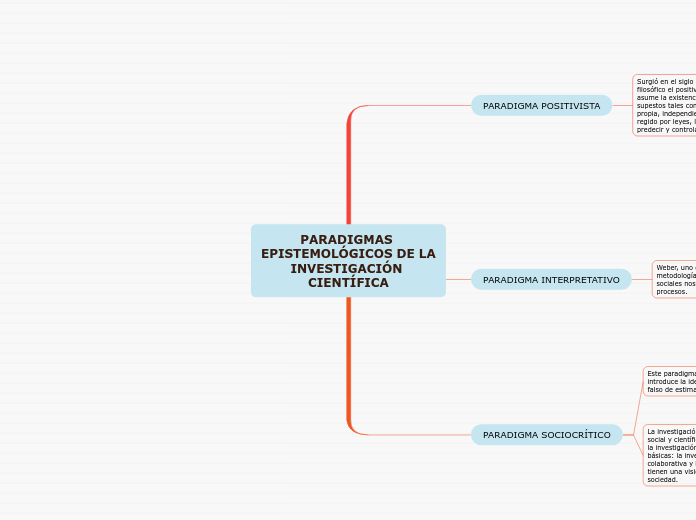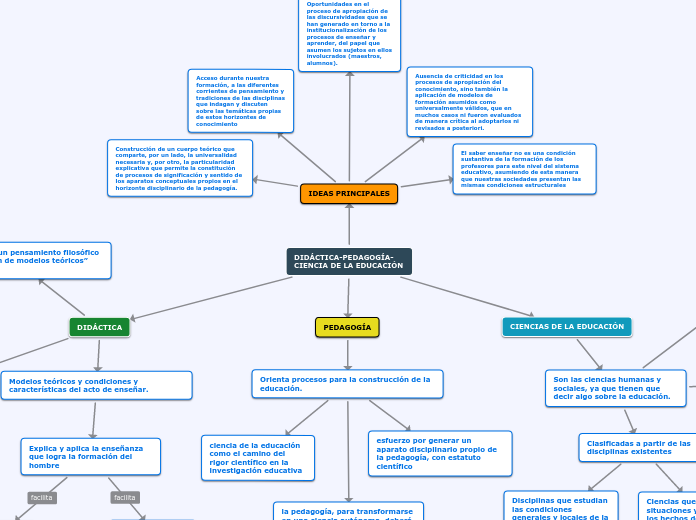PARADIGMAS EPISTEMOLÓGICOS DE LA INVESTIGACIÓN CIENTÍFICA
To name your story, you have to think about the overall message and what you want your audience to understand from the story. Also, make it relevant and easy to remember.
PARADIGMA SOCIOCRÍTICO
The ending of a story is essential. We all know that if the ending is weak, what happened before loses its importance. So make it unpredictable, but fair. A resolved ending answers all the questions and ties up any loose threads from the plot.
La investigación sociocrítica parte de una concepción social y científica holística, pluralista e igualitaria. En la investigación sociocrítica se distinguen tres formas básicas: la investigación-acción, la investigación colaborativa y la investigación participativa. Todas tienen una visión activa del sujeto dentro de la sociedad.
This is the closure section of the story.
See examples of possible outcomes below:
- all problems have been solved
- it's clear how each one of your characters ends up
- your main character is transformed by the challenge
Colás Bravo (Buendía Eximan, Colás Bravo y Hernández Piña, 1999:261) enmarca a las formas investigativas del paradigma sociocrítico dentro del cualitativo y las llama métodos cualitativos de investigación para el cambio social, los cuales fundamenta en la acción, la práctica y el cambio.
La autora señala como elementos clave que unen a los tres tipos de investigación los siguientes: -SE FUNDAMENTA EN LA CIENCIA DE LA ACCIÓN. -EL CONOCIMIENTO SE ENRAIZA <> Y <> LA ACCIÓN. -LA CONTRUCCIÓN DE LA REALIDAD. -CONOCIMIENTO EXPERIENCIAL
Los seres humanos son cocreadores de su propia realidad, en la que participan a través de su experiencia, su imaginación e intuición, sus pensamientos y acción; ella constituye el resultado del significado individual y colectivo.
Try answering these questions to come up with a closure:
- Have all the problems been solved?
- Is there a clear picture of what happens with each character in the story?
- Has the challenge transformed your main character?
- How do the characters feel in the end?
Este paradigma, a diferencia de los anteriores, introduce la ideologia de forma explícita, ante lo falso de estimar la neutralidad de las ciencias.
This is the moment when the main character surpasses the last obstacle and finally faces their greatest challenge.
The climax usually follows one of these patterns:
- realization
- resolution
- choice
Type in your answer.
Trata de desenmascarar la ideología y la experinecia del presente, y en consecuencia tiende a lograr una conciencia emancipadora, para los cual sustentan que el conocimiento es una vía de liberación del hombre.
PARADIGMA INTERPRETATIVO
The middle of the story is where you add layers of complications that will lead to the end. Reveal more about the character's journey. Did their personality go through changes? How did they overcome the challenges? And as you build up the story’s central conflict, make it more personal to that character. Also, from the middle act, you have to lead into the final act.
Weber, uno de los mayores representantes de la metodología cualitativa, expresó que, en las ciencias sociales nos concierne la tonalidad cualitativa de los procesos.
Each story has a main character and that character usually needs to solve a problem or challenge. The character's challenge is the one that creates tension throughout the story.
Según Patton (citado por Merino, 1995: 33-35), las características de la investigación del paradigma interpretativo son:
-INVESTIGACIÓN NATURALISTA. -ANÁLISIS INDUCTIVO. -PERSPECTIVA HOLÍSTICA. -DATOS CUALITATIVOS. -SISTEMAS DINÁMICOS. -ORIENTACIÓN HACIA EL CASO ÚNICO. -SENSIBILIDAD HACIA EL CONTEXTO.-NEUTRALIDAD EMPÁTICA. -FLEXIBILIDAD DEL DISEÑO.
Los paradigmas, como ya hemos expresado, representan una manera global de concebir la realidad y, por consiguiente, de abordarla científicamente, pero dentro de ellos existen diferentes enfoques.
Type in any other challenges which other characters in the story need to face.
En el interpretativo, estos son: la fenomenología hermenéutica, la etnografía, el interaccionismo simbólico y la etnometodología.
Se parte del presupuesto de que en las ciencias sociales la acción de los individuos siempre está gobernada por las significaciones subjetivas, las cuales no son observables y, por tanto, no pueden analizarse con los métodos cuantitativos.
In most stories, there are 3 challenges. The number 3 is a mystical number symbolizing completeness. Try to come up with interesting challenges with which your character needs to struggle.
See a few examples below:
- turns into a werewolf at night
- is sent back in time
La muestra siempre es intencional y su selección estará determinada por la amplitud, variedad e integración de las diversas realidades que convergen el objeto estudiado.
PARADIGMA POSITIVISTA
In the beginning of the story (or the exposition), you will need to introduce the setting and characters. You might also want to introduce the main conflict. This part of the story is important because it gives the reader necessary background information and maybe even a first insight into a character’s personality.
Surgió en el siglo XIX y tiene como fundamento filosófico el positivismo. La investigación positivista asume la existencia de una sola realidad; parte de supestos tales como que el mundo tiene existencia propia, independiente de quien lo estudia y que está regido por leyes, las cuales permiten explicar predecir y controlar los fenómenos.
Characters are essential to a good story. Usually, the protagonist(s) is/are the most affected by the plot. Introduce a character by focusing on their actions, interests, and occupation, as the physical appearance doesn't make a difference in most cases.
El experimento y la observación son considerados los métodos fundamentales del conocimiento científico. Los resultados objetivos y cuantificados obtenidos ecperimentalmente determinarán o no la validez de la predicción inicial.
Se busca una correlación o causa-efecto, donde los investigadores han de mantener una actitud neutral frente a los fenómenos.
Main Goal
Character traits
Type of character
Para el paradigma positivista el estudio del conocimiento existente en un momento dado conduce a la formulación de nuevas hipótesis, en las cuales se interrelacionan variables, cuya medición cuantitativa, permitirá comprobarlas o refutarlas en el proceso de investigación.
Type in the name of your character.
EL INTERÉS DOMINADOR DEL CONOCIMIENTO POSITIVISTA.
Add other qualities/attributes of the character.
LA EXPLICACIÓN CAUSAL O ERKLAREN COMO CARACTERÍSTICA DE LA EXPLICACIÓN CIENTÍFICA.
What is your character's main goal?
fight Evilfind lovedefeat his/her enemyrule the worldmake friendstime travelmake an awesome discoveryOther
EL MODELO O CANON DE LAS CIENCIAS NATURALES EXACTAS
Which traits best describe the character's personality? Choose more if necessary:
introvertedloyalkindindependentquick-thinkingadventuresomeidealisticsweet-naturedcalmrisk-takercreativewittystrictfussyweirdclumsyharshaggressivecarelessclingingcowardlycrueldeceitfulimpulsiveOther
Según Mardones y Ursúa (1982;19-20) reducidos los rasgos característicos de la investigación positivista serían estos: EL MONISMO METODOLÓGICO
Choose the type of your chacter:
Protagonist (main character)Antagonist (main character's opponent)Flat (stereotypical character)Round (his/ her personality develops throughout the story)Static (doesn't evolve as a person throughout the story)Dynamic (dramatical change in personality)Confidant (the main character trusts him/ her)Foil (contrasting character who enhances the personality of another character)Other










